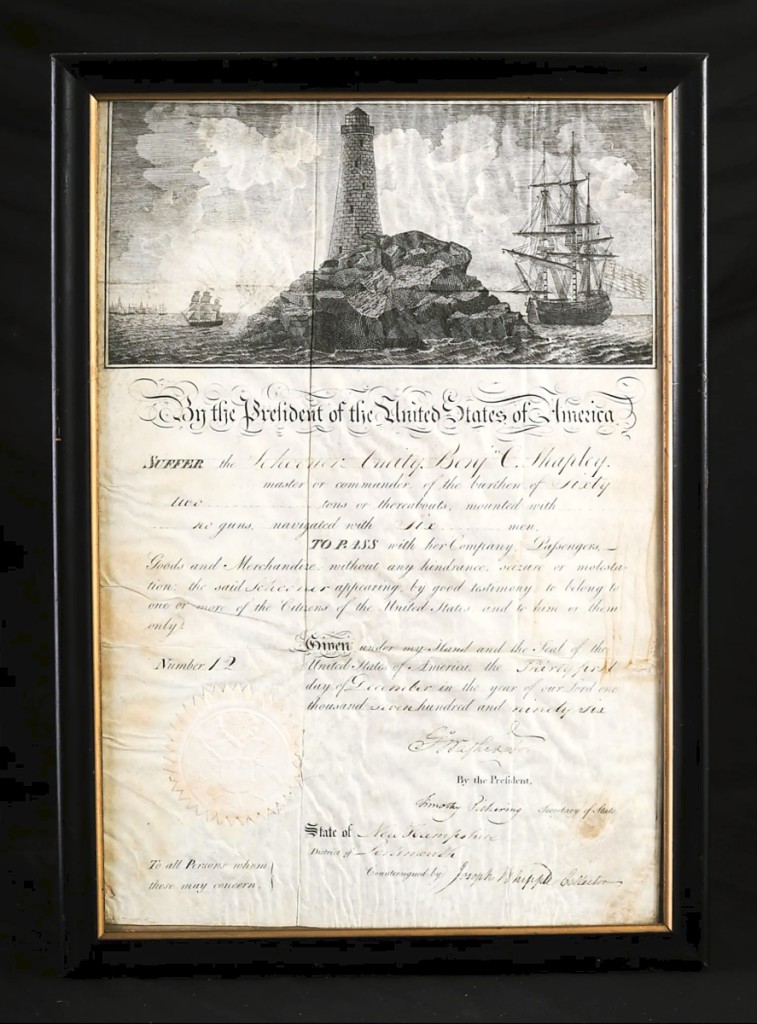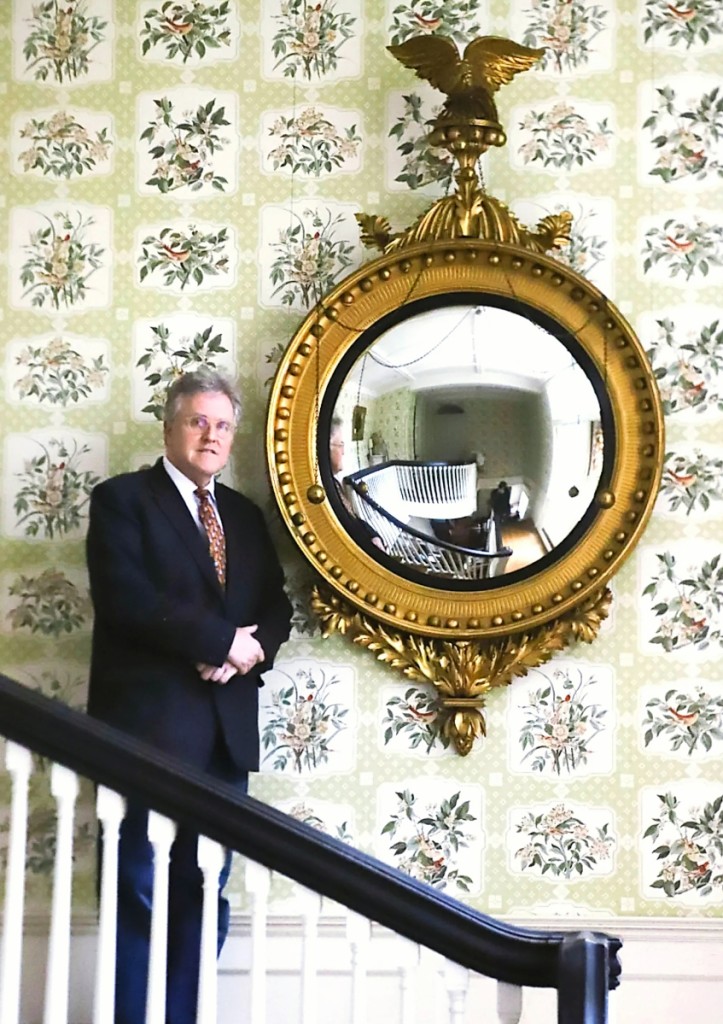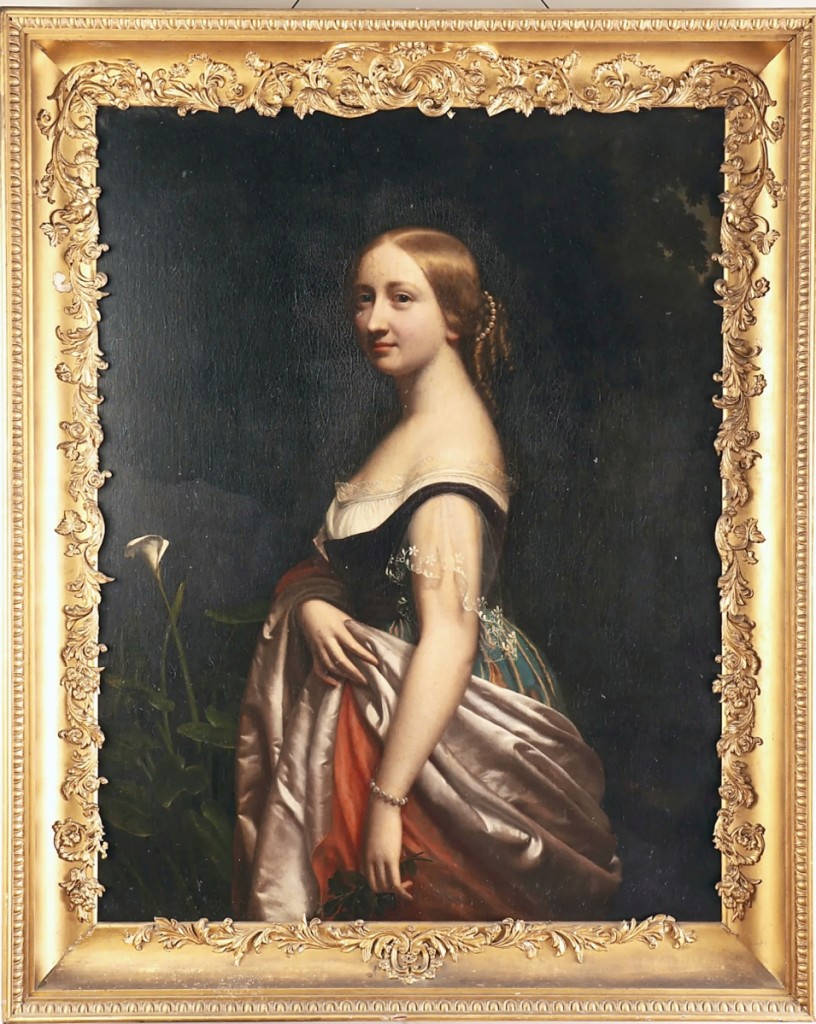
The sale’s top lot at $31,000 was a 1796 ship’s passport signed by George Washington and Timonthy Pickering. The document gave safe passage to the schooner Amity, whose master was Benjamin C. Shapley. McInnis said the passport was special for the engraving that appeared at the top in the presentation frame.
Review by Greg Smith, Photos Courtesy John McInnis Auctioneers
AMESBURY, MASS. – John McInnis had a busy December. The Massachusetts auctioneer offered more than 1,100 lots December 10-11 (see article here), and followed it up with 376 more a week later on December 18. The latter sale was onsite in Beverly, Mass., at the country manor estate known as Round Plain Farm, described by McInnis as a “long time Loring family home,” members of which were involved with the Walpole Society.
Many of these objects were passed down in the Loring family, a line that arrived to America in 1634 and played an outsized role in the early history of Massachusetts. The family has papers in the Massachusetts Historical Society and its name appears on historic homes in Boston and Hull.
“The house had been closed for a period of time, one of those big North Shore Boston mansions,” McInnis said. “The auction was great, even for a week before Christmas. We held it outside under a tent and people were in attendance.”
There were some treasures tucked into this sale.
Leading the lots at $31,000 was a 1796 ship’s passport signed by George Washington. The framed document gave safe passage to the schooner Amity, whose master was Benjamin C. Shapley. Also signed on the document was Timothy Pickering, the Secretary of State.
“The Washington piece did very well,” McInnis said. “The presentation frame with the engraving on top was special. I’ve not had a passport like that.” McInnis said it sold to a private collector.

John McInnis stands in to demonstrate the massive scale of the Nathaniel Bowditch Family convex mirror, which went out at $13,090. The 76-inch-tall mirror was purchased by Bowditch to furnish his residence in Salem, Mass., at 9 North Street, a historic home that stands today as the Nathaniel Bowditch House and serves as the headquarters for Historic Salem.
The auction house described the Nathaniel Bowditch Family convex mirror as “one of the most impressive mirrors of this type to come on the market in years.” McInnis stands next to the 76-inch-tall mirror in the lot photo, demonstrating its massive scale. He said he had never handled a convex mirror of this size before. It appeared in a gilt frame surmounted by a carved American eagle with outstretched wings holding a four brass-ball chain in its mouth above carved flora. The mirror was offered together with a copy of Bowditch’s Practical Navigator sixth edition 1826 and a silverplated tray engraved Alfred Bowditch 1901. It had passed down in the family and was originally purchased by Alfred Bowditch between 1811 and 1823, when he lived in Salem, Mass., at 9 North Street, a historic home that still bears his name and now serves as the headquarters of Historic Salem, the preservation group. According to Historic Salem, Bowditch’s Practical Navigator is still carried on board every commissioned US Naval vessel. The mirror would sell for $13,090.
In silver, lots exceeded their value by weight. Coming in at $11,900 was a sterling tray with a repeating Art Nouveau thistle pattern to the border by Arthur Stone. It was engraved “APL and EL from WCL and SML June 3, 1909.” Training in England and Scotland, Stone arrived to the United States in 1884, afterwards setting up a shop in Gardner, Mass.
Augustus P. Loring, husband to Elizabeth, was a member of the Walpole Society and actively engaged in the arts. The son of August Augustus P. and Rosamond (Bowditch) Loring, Augustus would become the head of the Boston Athenaeum and made headlines in 1979 for proposing the sale of Gilbert Stuart’s portraits of George and Martha Washington, then the most valuable object in the library’s collection. He was further a president and trustee of the Peabody Museum in Salem, to which he left his collection of charts and views.
Furniture found its leader at $9,920 with a Federal-style inlaid breakfront surmounted by a carved eagle and urn finials. The cabinet was purchased in the 1960s for $22,000 from the Stockwell Gallery. A similar example went on exhibit at Winterthur in the 1960s. McInnis said it sold to a collector “just down the road” from the home. Furniture was further added to by Arts and Crafts examples as a Roycroft desk with through-tenon construction sold for $4,650 and a Stickley bookcase with glazed doors took $3,570.

A portrait by Spiridione Gambardella would bring $8,330. The painting was completed in 1838 when the artist was active in New York City and exhibiting at the National Academy of Design. Oil on canvas, 47 by 37½ inches.
Fine art was led by a number of portraits, many of them family members. Selling for $8,330 to the Beverly Historical Society was a portrait of Ellen Gardner Loring. It had been commissioned by her husband, Augustus Peabody Loring, as a copy of an original portrait that John Singer Sargent had earlier done and which hung in Loring’s Pine Hill, Beverly, Mass., home, which burned down and took the original portrait with it. Fortunately, Loring had earlier commissioned this portrait from a student of the Boston Museum School as he wanted an example at both of his estates. McInnis said the Beverly Historical Society was successful in acquiring at least three portraits of Loring or Bowditch family members. At the same price was a portrait of an unknown woman by Italian artist Spiridione Gambardella. The Gambardella was the better portrait and had passed down in the family through Elizabeth Peabody Loring, who married Caleb William Loring. Gambardella exhibited at the National Academy of Design in 1838 and 1839, in addition to the Boston Athenaeum and the Pennsylvania Academy of Fine Art. This portrait was painted in 1838.
Ellen Gardner Loring’s brother, John Lowell Gardner, was featured in a 1910 portrait by Mary Isaac Brewster Hazelton that sold for $6,200. Hazelton was a Boston Museum School artist, where she taught drawing and painting alongside Edmund Tarbell, Joseph DeCamp and Frank Benson, whom she shared rent with at Fenway Studios. Both Ellen Loring and John Gardner were niece and nephew of arts patron and museum founder Isabella Stewart Gardner.
Selling for $8,033 was an Eighteenth Century American School portrait of an unidentified merchant. McInnis said a Loring family member purchased it, presumably aware of the sitter. The oil on canvas measured 34 by 30 inches.
“We set the preview up in the house and that worked out well,” the auctioneer concluded. “There was a lot of room for people, they never felt confined. Under the tent outside, the sale was great – it was a lot of fun to do.”
All prices reported include buyer’s premium. For information, www.mcinnisauctions.com or 978-388-0400.






.jpg)













